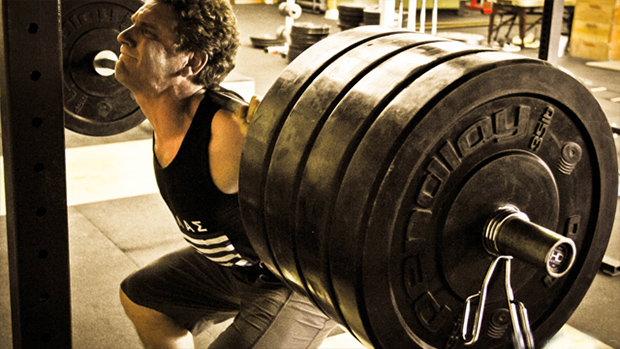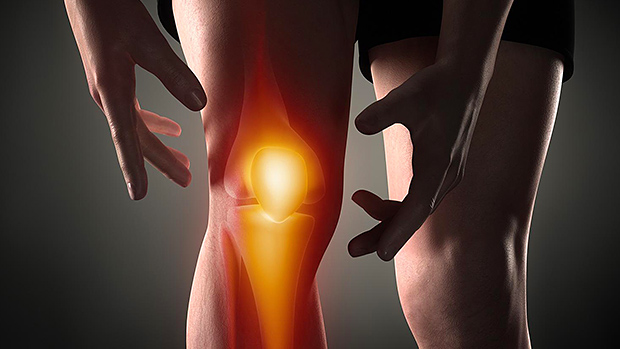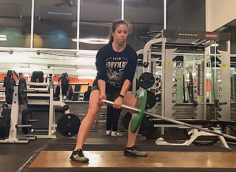Here's what you need to know...
- Many of the pointers given to squatters are intended for those who are wearing supportive gear.
- There's no need to prioritize the posterior chain when trying to bring up your squat. Squat strength depends on quad strength.
- To improve your squat technique, practice wall squats. To increase leg strength, practice front squats.
- Improve your form at the bottom of the squat by focusing on driving your upper back into the bar.
Raw or Geared?
Most of the advice you hear on the squat is written by geared lifters for geared lifters – those who use special suits, heavy wraps, and other forms of supportive gear.
While that information has value, a lot of it would be unsuitable for a raw squat – "raw" meaning free of gear.
Case in point: Sitting back. This is probably the most overused pointer, and it's directed mostly at the geared lifter.
Luckily there's some no-fail advice that raw lifters can use to improve squat performance. But first let's go over a few things that don't help.
Needless Advice for Raw Squatters
Let's clear up some misinformation. There are two things you can disregard when trying to bring up your squat.
- You must prioritize the posterior chain.
- You must do good mornings to strengthen your posterior chain.
It's been drilled into our heads that we need to be more posterior-chain dominant, but the truth of the matter is the squat is supposed to be a leg movement.
A lower bar position on your back will tend to make you bend over more. This is totally fine, but the intent should always be to stay as upright as possible. The more bent over you are, the more lower back and hamstrings you'll use. But don't forget about the quads.
Many of the top raw lifters and all-time greats prioritized quad training. The focus wasn't on glutes, hamstrings, or lower back, but more on quads.
The quads have a ton of potential for growth. More hypertrophy will give you a higher ceiling for strength. Look at any great Russian squatter. They all have insane quad development. When you see muscle hanging off of your knees, don't be surprised when your squat goes through the roof as well.
Out of the hole, you should always try to lead with the upper back first. Watch any world class squatter. Nearly everyone – both geared and raw – will try to lead with the upper back first out of the bottom.
As a powerlifter, it's critical to save your lower back so you have back power left when your deadlift comes around. If you use your lower back too much when you squat you aren't going to have much left when you deadlift whether you're training or in meet.
Good mornings, which are a great exercise to train the back and hamstrings, aren't necessary for squatting world record weights.
In the past I tried doing lots of good mornings with no luck. I got really good at good mornings, but my squat went nowhere. I got to the point where my good morning was stronger than my raw squat and I was able to hit 600 for 5 with the giant cambered bar.
While my good mornings got a lot of attention, they didn't do much for my squat total.

Photo Credit: CrossFit Impulse, Alabama
3 Keys to the Raw Squat
1 – Technique
It's damn near impossible to do a wall squat with poor technique. That's what makes wall squats the best drill to teach you how to squat properly.
Simply face a wall and perform some body weight squats. If you lean too far forward your face will smash into the wall. If your knees come too far forward your knees will hit the wall. In both cases you won't be able to achieve proper depth without hitting the wall. It's a self-correcting tool.
The only thing to watch out for when performing wall squats is that you don't roll up onto the outsides of your feet to squat down.
Make sure your feet are firmly planted so that your big toe, heel and mid-foot have contact with the floor. Sit back and drive your knees out hard just enough to hit proper depth, and don't overdo either one.
Try using wall squats in a number of ways:
- For warming-up: Start with 3 sets of 5 wall squats before getting under a bar. Aside from practicing technique, it'll warm up the hips and ankles before a heavy squat session. When my wall squats feel smooth I know I'm going to have a great squat session.
- Self-training: If you're a newer lifter, perform wall squats before you even touch a bar to ingrain the proper pattern. Most lifters don't learn strength like a skill. Squatting is an athletic movement just like a golf swing or a baseball throw. It requires technical precession and the wall squat is the best way to achieve this.
- Assistance work: Using the wall squat for high reps is a great way to great extra work in. Try doing this with a band around the knees in order to work the hips.
You can also do these isometrically with the band to learn to constantly push out and engage the hips for an extended period of time. This will keep your knees from caving in when the weights get real heavy.
2 – Leg Strength
Most people think they fold over in a squat because their lower backs are too weak. This may be true for some, but more often than not, if your legs aren't strong enough you'll feel compelled to shift the load to the lower back since you can't keep your hips under the bar.
The best exercise to help you keep your hips under the bar by building leg strength is the front squat. It's a challenge because you can't fold over at all. If your torso comes too far forward you'll dump the bar. Like the wall squat, it's a self-correcting exercise.
When you front squat, you're going to be more upright, and your knees will come forward more than they would during a traditional back squat.
There are two main ways to front squat.
- The cross-arm grip is great for people with limited mobility. If your main focus is just strength this is completely fine.
- If you're a competitive weightlifter then you need to learn how to properly rack the bar and utilize the clean grip. I prefer the clean grip because you can't use your arms at all to assist you.
Since it requires a little bit more mobility, warm up before you go into your front squats. Here is a favorite I use every time to prepare my upper body for the proper rack position.
There are three reasons to make front squats a staple:
- New lifters: If you're new to squatting, the front squat should be a primary movement for your first few weeks. Use as a primary exercise and do 3-6 reps at a time. If you're on a Westside split the front squat can also be thrown in as a max effort exercise from time to time.
- As a supplemental move: Front squats are a great secondary movement to help build the squat. When done as a second move use higher reps in the 5-8 rep range for multiple sets.
- For deloading or building phases: If you're an experienced lifter coming off a meet, it'd be wise to use front squats as a deload.
Since you can't front squat as much as you back squat, you won't be loading the spine nearly as much. Use front squats as your main movement while your body heals up. You'll go into your next training cycle feeling fresh and ready to go.
3 – Intent Out of the Hole
Lifters fail squats when their backs are comprising. This may be a result of too much forward lean or the hips shooting up too fast.
The best way to correct this is by correcting your focus. Think about driving your upper back into the bar on the way up.
A great way to practice and build strength in this position is the high-bar pause squat. The high-bar squat will allow the lifter to stay a bit more upright than a regular squat, but not quite as upright as a front squat.
Pausing in the bottom gives you a chance to find your groove and focus on the proper ascent. That way you can rise up focusing on driving back into the bar with your upper back.
A pause squat will help you build strength out of the hole and find your perfect bottom position.
A longer pause will help you ingrain a proper position. If you're too far forward or too far back you aren't going to be able to sustain that position for very long. If your technique is good, you'll be able to sit in the hole with no problem. It will still suck, but you'll be able to drive back up and ultimately finish the lift.
Tip: To help you stay upright and use your legs more, do these with weightlifting shoes that have a raised heel.
It gives you artificial ankle mobility since you start in a position of plantar flexion. This will allow you to let your knees drift forward more while still keeping your heels on the ground allowing for a more upright and quad dominant squat.
If you don't have access to weightlifting shoes, performing these old school with 10 pound plates under your heels is totally fine. Just make sure you walk out carefully and keep your balance as you come back.
There are plenty of reasons to use high-bar pause squats:
- As a primary exercise: Do anywhere from 3-5 reps and even singles on occasion. As you get closer to a meet using regular squats is advised. If you need a break from the straight bar, utilize pause squats with a safety squat bar in order to give the shoulders a rest and tax the legs and the back simultaneously. The safety squat bar will teach you to use your upper back when squatting upward.
- Supplemental move: Use them as a second exercise to help you build the squats. Do 1-3 second pauses, 5-8 reps for 3-5 sets.
- Dynamic effort work: Use pause squats as speed work. This can be done with straight weight or with accommodating resistance.
The key here is trying to generate as much speed as possible out of the hole and driving back up with the upper back. Learning to squat powerfully from the bottom will teach you to drive through sticking points and ultimately achieve new personal bests.
Final Tips and Recap
- Don't overthink the cues and advice used by geared lifters if your goal is raw strength and size.
- Good mornings are fine but aren't necessary for a huge squat.
- Sitting back and driving the knees out hard are great cues but don't exaggerate either one.
- Focus on screwing your feet in the ground and spreading your groin apart as you sit between your feet.
- Use the wall squat to ingrain proper squat technique.
- Use front squats to build leg strength and to practice staying upright.
- Perform pause-squats to build strength out the bottom, find your groove, and practice driving your upper back into the bar.





